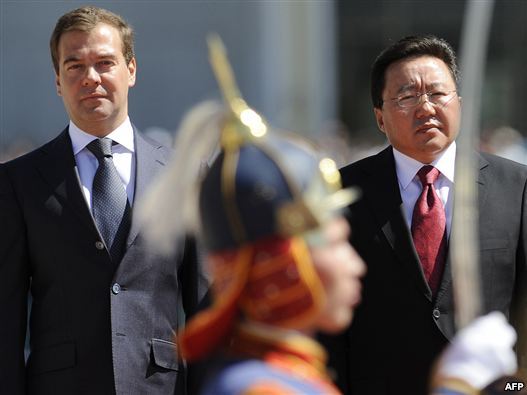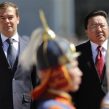
Russian-Mongolian Defense Cooperation and Selenga 2011
Publication: Eurasia Daily Monitor Volume: 8 Issue: 172
By:

Russia and Mongolia staged the Selenga 2011 antiterrorist exercise during the first week in September, which if placed in a wider context of Russian defense cooperation and shifts occurring in scenario planning for its military exercises may reveal adjustments in Moscow’s security thinking. Selenga 2011 was held in northern Mongolia from September 3-10, involving 500 servicemen on both sides and 200 pieces of military hardware and specialist equipment (ITAR-TASS, September 3).
Russia sent units to participate in the exercise drawn from the 36th Motorized Rifle Brigade based in Borzya, 40 kilometers (km) from the Mongolian border. The brigade forms part of the 36th Combined Arms Army (CAA) in Eastern Military District (MD) and Selenga 2011 was placed under the command of Major-General Vladimir Tsilko, the Commander of the 36th CAA. An infantry company reinforced by a tank platoon and logistical support from the 36th MRB conducted a series of tactical maneuvers involving dated T-72 tanks, BMP-2 armored vehicles and other hardware. The original plan envisaged using Mi-24 helicopters, but due to the Mi-24 air accident in Primorye on August 24 these were grounded pending inspections and therefore were withdrawn from the exercise (https://egov-buryatia.ru/index.php?id=4&tx_ttnews[tt_news]=23829&cHash=469fc0514c8736e20812fca4cc33ac96, September 2).
On September 8, Interfax cited Lieutenant-Colonel Igor Muginov, the spokesman for the Eastern MD as stating that notional terrorists were destroyed using a range of firepower including a combat helicopter unit at the Tavan-Tolgoy training range 60 km from Ulaanbaatar. Muginov may have been referring to a Mongolian helicopter unit. Xinhua noted the presence of a Mongolian infantry unit and that the first stage of Selenga 2011 was held in the Burduny training range in the southern Siberian Buryatia Republic, which hosted a similar joint exercise in September 2010. The bilateral exercise was designed around Russian servicemen sharing with their Mongolian counterparts their approaches to countering illegal armed formations. On September 4, Russian servicemen began arriving in northern Mongolia, conducting marches, while heavy equipment was transported by rail (Interfax, September 8, 5; Xinhua, September 5).
Moscow has gradually reactivated and deepened its ties with Ulaanbaatar. In November 2000, the then Russian President Vladimir Putin concluded a visit to Mongolia by signing the Ulaanbaatar Declaration containing 25 points, laying the legal foundation for the restoration of bilateral relations. During his trip to Russia on December 4-9, 2006, the then Mongolian President Nambaryn Enkhbayer signed the Moscow Declaration, which marked a fuller resumption of their ties. By 2009, both countries held regular meetings at the levels of president and prime minister. President Dmitry Medvedev ended his visit to Ulaanbaatar on August 26, 2009 by signing a strategic partnership document. This included among other agreements, deepening cooperation in mineral resources and developing transportation infrastructure. The two countries formed a new joint venture “Infrastructure Development Company” to improve railroads in Ulaanbaatar and link the Tavan Tolgoi coalmine to the existing railroad network. Medvedev stated during this visit that Russia had made a strategic miscalculation by underestimating the importance of Mongolia for too long (Renmin Ribao, August 27, 2009; EDM, November 3, 2010).
In terms of defense cooperation, a number of factors compelled Moscow to pay closer attention to Mongolia. The first annual US-Mongolian military exercises were held in 2003, followed by an intensification of US military assistance to Mongolia. NATO also became more actively engaged with the country, while Mongolia participated in international peace support operations, sending military personnel to Iraq, Kosovo and in February 2010 joining the International Security Assistance Force (ISAF) in Afghanistan (https://www.nato.int/cps/en/natolive/news_62450.htm, March 29, 2010). Thus, Mongolia emerged as a valued contributor to NATO-led operations. Ulaanbaatar deployed a platoon to the NATO-led KFOR in Kosovo in December 2005, and following its entry into ISAF the country has been involved in force protection in Feyzabad and has dispatched infantry, artillery and air mentor trainers to the NATO training mission in Kabul. In May 2011, Mongolia sent an infantry platoon to strengthen security at Kabul international airport (https://www.nato.int/cps/en/SID-E699B7FA-7037787F/natolive/news_74801.htm?selectedLocale=en, May 25-27, 2011). While Moscow has been critical of western military engagement in Central Asia and the South Caucasus, it has proved less outspoken on Mongolia.
Moreover, since the Mongolian Armed Forces remain heavily reliant upon Russian made weapons and equipment, there is potential for increased arms sales. On August 16, Luvsanvandangiyya Bold, the Mongolian Defense Minister, stated that as the country seeks to modernize its armed forces this will demand purchasing Russian weapons. The Mongolian defense ministry has reportedly expressed interest in procuring small numbers of MiG-29 fighters. During a military parade in Ulaanbaatar on July 11, two mobile launchers of the Russian made S-125M Pechora air defense system and 20 BTR-80 armored personnel carriers were on display. Bold suggested that the procurement plans include upgraded air defense systems and additional hardware (Center for Analysis of the World Arms Trade, August 22).
While Moscow has a variety of interests at stake in deepening its defense cooperation with Mongolia and attaching greater strategic significance to the country, Selenga 2011 was notable for aspects of the antiterrorist scenario. The exercise scenario involved the “appearance” of “illegal armed formations” on the territory of northern Mongolia, seeking to exploit domestic instability and provoke a worsening of the security situation in the area. This extended to these formations trying to capture key targets such as oil platforms, schools and communications centers. Ulaanbaatar then appealed for Russian military assistance and subsequently a combined Russian-Mongolian military operation was conducted to “block and destroy” enemy formations and restore public order. The scenario was therefore built around militants seizing towns in an attempt to establish an independent state in northern Mongolia (Interfax, September 2, 1; ITAR-TASS, September 2).
Selenga 2011 appears therefore to offer a clue about Moscow’s security thinking, which makes sense when understood against the backdrop of the deep challenges facing the effort to reform and modernize the Russian armed forces. Since the reform was launched in the aftermath of the Russia-Georgia war in August 2008, the combat capabilities and combat readiness of Russia’s conventional armed forces has declined (Nezavisimoye Voyennoye Obozreniye, September 16). The poorly equipped Ground Forces’ brigades are undermanned, staffed with fewer contract personnel, inadequately trained twelve month serving conscripts rotating in and out of the units biannually, without a proper non-commissioned officer cadre and a largely unreformed officer corps. Consequently, Russia’s ability to project power remains very limited, and its bilateral and multilateral military exercises conducted on its periphery seems to convey an overall message of reluctance to act alone.




